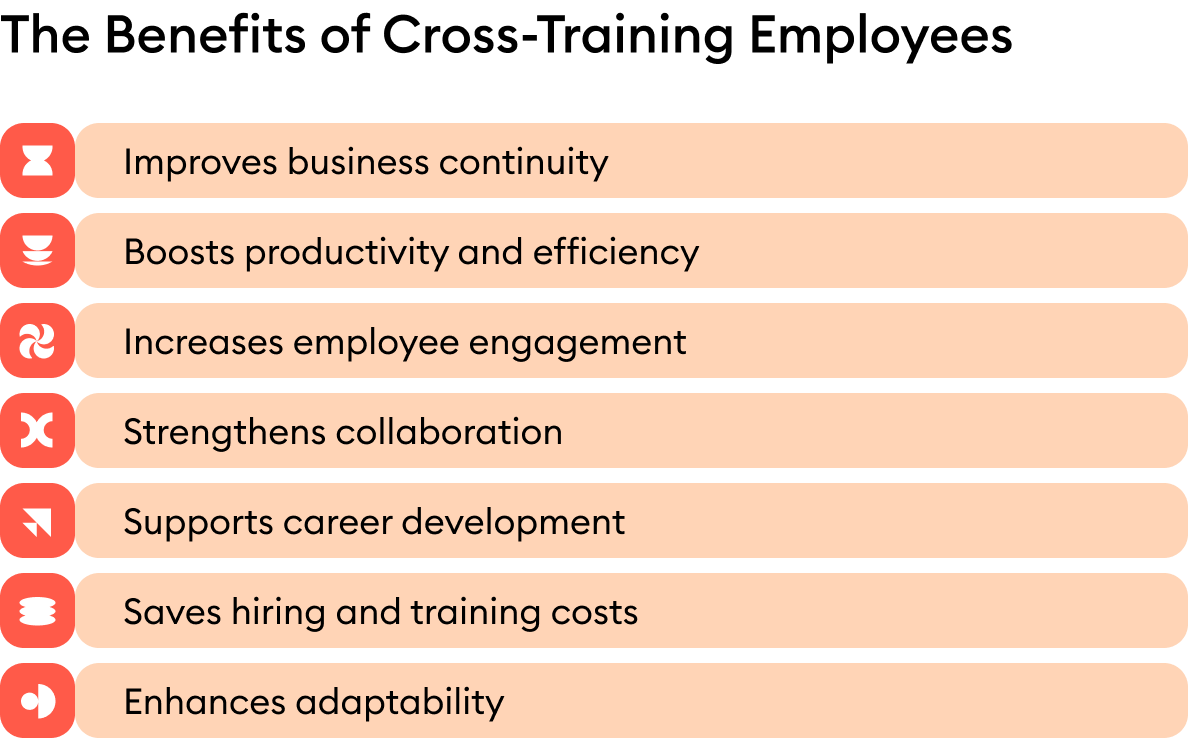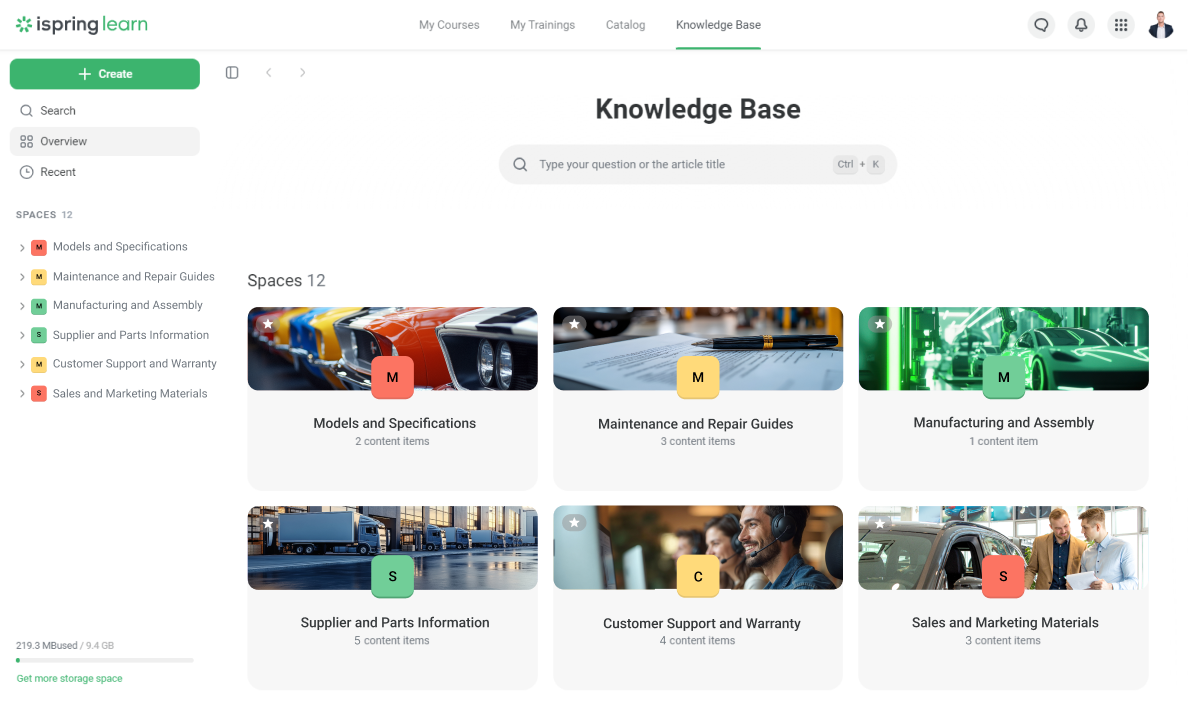Cross-Training Employees: Key Benefits and Strategies

In a rapidly changing job market, businesses need adaptable employees who can step into different roles when needed. That’s exactly what cross-training employees is about—expanding skills beyond a single role to build a more flexible, resilient workforce.

- What employee cross-training is and how it differs from multitasking.
- The benefits of cross-training for both businesses and employees.
- Common pitfalls and tips to avoid employee burnout or skill gaps.
By the end of this article, you’ll have a clear, actionable strategy to create a cross-training plan for employees that strengthens your organization — without overwhelming your team.
What Is Employee Cross-Training?
According to McKinsey’s 2024 report, companies that embed resilience and adaptability into their training programs are better equipped to navigate uncertainty.
That’s where cross-training comes in.
Cross-training is the process of teaching employees skills beyond their primary roles, providing them with the flexibility to take on different responsibilities when needed.
Instead of being confined to a single role, employees gain a working knowledge of other job functions, making teams more agile and prepared for change.
A well-structured cross-training program isn’t just about covering for absent colleagues—it’s about skill development, personal and professional growth, and internal mobility. It fosters collaboration, empowers employees, and ensures that operations run smoothly, even when key team members are unavailable.
Cross-training vs. multitasking
A common misconception is that cross-training and multitasking are the same. They’re not.
- Multitasking means juggling multiple tasks at once—often at the cost of quality and efficiency.
- Cross-training focuses on deep learning, helping employees master specific skills that prepare them for new responsibilities. Rather than juggling tasks, employees develop expertise in new roles over time.
Why cross-training matters in today’s workplace
Today, workplaces are more dynamic than ever. Unexpected absences, job openings, and shifting priorities can disrupt operations if teams aren’t prepared. That’s where cross-training opportunities make a difference.
For businesses, it reduces disruptions, improves efficiency, and maximizes internal talent. For employees, it opens the door to career growth, increased engagement, and job satisfaction.
However, not all cross-training initiatives are effective. If handled poorly, they can feel like an added responsibility with no reward, leading to frustration or burnout. That’s why businesses must develop structured training opportunities that benefit both the company and the employees.
The Benefits of Cross-Training Employees
Cross-training is more than just a backup plan—it’s a strategic investment that strengthens both businesses and employees. For companies, it helps maintain business continuity, improve productivity, and reduce costs. For employees, it provides opportunities for career development, enhances job satisfaction, and increases engagement.
Cross-training builds an agile workforce that adapts to disruptions, improves collaboration, and drives long-term success. Below, we break down the key benefits of cross-training employees and how it impacts both the organization and its people.

Improves business continuity 
No company is immune to employee absences, whether due to vacations, sick leave, or unexpected departures. Without a backup plan, these absences can slow down operations, create bottlenecks, and frustrate both employees and customers.
A well-executed cross-training process ensures that essential tasks don’t grind to a halt when a key team member is out. When employees develop a working knowledge of multiple roles, they can step in and keep operations running smoothly. This is especially critical in industries where timely execution is crucial, such as customer service, manufacturing, and healthcare.
Boosts productivity and efficiency 
Workplace inefficiencies often stem from a lack of trained personnel in key areas. When only one person knows how to perform a particular task, the entire team becomes dependent on them, leading to delays and workflow disruptions.
Cross-training’s goal is to help businesses eliminate these bottlenecks. When multiple employees are trained to handle major tasks, work doesn’t slow down if one person is unavailable. This speeds up decision-making, optimizes workflows, and allows businesses to function more smoothly and efficiently.
Increases employee engagement 
A stagnant work environment leads to low motivation and high turnover. Employees who feel like they’re doing the same tasks every day without growth opportunities can become disengaged. This can result in lower productivity, decreased job satisfaction, and an increased risk of burnout.
By offering this initiative, businesses give employees a chance to learn, grow, and take on new challenges. This creates a more engaging workplace where employees feel valued and motivated. As a result, companies benefit from higher retention rates, improved morale, and a more enthusiastic workforce.
Strengthens collaboration 
Departments often operate in silos, with employees focusing only on their specific tasks and having little understanding of how other teams function. This can lead to miscommunication, inefficiencies, and a lack of teamwork.
Cross-training breaks down these barriers by providing insight into other job functions. Peer-to-peer learning fosters a greater appreciation for different roles, enhances collaboration, and cultivates a culture of mutual support. This not only improves teamwork but also strengthens problem-solving across the organization.
Supports career development 
Many employees leave jobs because they feel stuck in a dead-end job with no opportunity for advancement. If companies don’t provide clear pathways to professional growth, they risk losing valuable talent.
Cross-training opens up internal mobility, helping employees expand their skill sets and prepare to become future leaders. By gaining experience in different functions, employees increase their value within the company and become more adaptable to changing business needs. This benefits both the individual and the organization, as companies retain skilled, motivated employees who are invested in their long-term growth.
Saves hiring and training costs 
Hiring new employees is expensive and time-consuming. The process of posting job openings, interviewing candidates, and onboarding new hires requires significant investment, both in terms of money and resources.
Instead of constantly recruiting new talent, businesses can maximize their existing workforce by offering cross-training programs for employees. Training current employees to take on additional responsibilities reduces the need for external hiring while ensuring that the workforce remains skilled and capable. This approach not only lowers costs but also shortens the learning curve, as existing employees are already familiar with company processes and culture.
Enhances adaptability 
In today’s fast-changing business landscape, adaptability is key to survival. Companies that rely too heavily on highly specialized roles may struggle to respond to market changes, unexpected challenges, or sudden shifts in demand.
By training employees in multiple job functions, businesses create a more resilient, flexible workforce. Employees with diverse skill sets can take on new responsibilities when needed, allowing companies to pivot quickly in response to new trends or challenges. This agility gives businesses a competitive edge, ensuring long-term sustainability.
The Risks and Challenges of Cross-Training Staff
While cross-training can bring many benefits, it’s not without its challenges. If not carefully planned and managed, it can lead to burnout, resistance, and unintended skill gaps. Employees may feel overworked, managers might hesitate to share responsibilities, and businesses could risk losing specialized expertise.
Here’s what can go wrong with cross-training—and how to avoid common pitfalls.
Increased workload without proper compensation
One of the biggest risks of cross-training is expecting employees to take on additional responsibilities without adjusting their workload or pay. If cross-training feels like an unfair increase in duties rather than an opportunity for growth, employees may become frustrated, disengaged, and even consider leaving.
To prevent this, companies must set clear expectations, adjust compensation when necessary, and ensure that new tasks don’t overwhelm employees. Instead of simply piling on extra work, businesses should create a structured learning plan that allows employees to develop new skills without feeling exploited.
Resistance from employees or managers
Not everyone will be enthusiastic about cross-training. Employees may see it as a distraction from their core responsibilities, while managers might hesitate to share key tasks with others. Some employees might worry that learning additional skills will lead to more work without extra pay, while others might feel insecure about stepping outside of their comfort zones.
To overcome resistance, businesses must communicate the benefits clearly. Employees should understand that cross-training isn’t just about filling in gaps—it’s an opportunity for growth, career development, and increased job security. Managers, on the other hand, need to see how cross-training can improve team performance and reduce dependency on key individuals. Offering incentives, recognition, and structured training programs can help ease concerns and encourage participation.
Potential skill dilution (jack of all trades, master of none)
A well-rounded workforce is great, but there’s a fine line between being versatile and being stretched too thin. When employees are cross-trained in too many areas, they might struggle to develop expertise in any one field. This can lead to lower overall skill levels and reduced performance in critical roles.
To avoid this, businesses must balance breadth and depth. Cross-training should enhance an employee’s skill set without distracting from their primary strengths. Instead of training employees in every possible function, focus on complementary skills that improve their efficiency and career prospects without compromising quality.
How to implement an effective cross-training program
A well-designed cross-training program doesn’t just happen—it requires planning, structure, and ongoing evaluation. Without a clear strategy, cross-training can become disorganized, feel unfair, or even backfire, leading to negative outcomes. To make it work, businesses need to define objectives, engage employees, and ensure long-term success.
1. Set clear goals and expectations – Define what success looks like
Before launching a cross-training initiative, companies must identify why they are implementing it and what they hope to achieve. Is the goal to reduce workflow bottlenecks, improve employee engagement, or strengthen succession planning?
For example:
- Reducing workflow bottlenecks – training customer support agents to handle basic billing inquiries can ease pressure on the finance team.
- Improving employee engagement – allowing employees to explore different roles can boost motivation and career satisfaction.
- Strengthening succession planning – preparing high-potential employees to take on leadership roles ensures business continuity.
Clear objectives help employees understand the value of cross-training and how it benefits both them and the business. It’s also essential to define success metrics—whether it’s faster task completion, lower employee turnover, or improved teamwork. Without clear goals, cross-training risks becoming an aimless exercise rather than a strategic advantage.
2. Create a structured employee cross-training plan
Cross-training should never be informal or inconsistent. Without a structured plan, employees might receive unequal training experiences, leading to gaps in knowledge and skill development.
A well-thought-out cross-training plan for employees should outline:
- Who gets trained – prioritize employees based on business needs and the individual’s career aspirations.
- What skills are covered – focus on complementary and high-impact skills instead of overwhelming employees with developing multiple abilities.
- Training duration – avoid rushed learning; set realistic timelines for mastery.
- Who leads the training – Assign mentors or senior employees to provide hands-on guidance.
| Description | Example | |
| Who gets trained | Employees selected based on business needs and their career aspirations. | A customer support agent learning basic marketing skills. |
| What skills are covered | Focus on complementary, high-impact skills. | A sales rep developing financial analysis skills. |
| Training duration | Set realistic timelines for mastery, not rushed learning. | An IT specialist spending three months shadowing the cybersecurity team. |
| Who leads the training | Assign mentors or senior employees to guide the process. | A senior designer coaching a junior marketer on visual storytelling. |
By ensuring a step-by-step approach, businesses can maximize engagement and effectiveness.
3. Ensure fairness and recognition – avoid overloading employees without incentives
One of the biggest pitfalls in cross-training is pushing additional work onto employees without acknowledging their efforts. If employees feel they are simply taking on extra tasks without rewards, they may resent the program and disengage.
To prevent this:
- Acknowledge and reward effort – recognize employees who take on new responsibilities.
- Ensure fair distribution – avoid overloading a few employees while others remain unaffected.
- Link training to career growth – show how cross-training opens up new opportunities and promotions.
When employees see personal and professional benefits, they are more likely to embrace cross-training instead of resisting it.
4. Engage employees in active learning – use job rotation, mentoring, and simulations
Cross-training isn’t just about watching presentations or reading manuals—hands-on experience is key. The best programs incorporate practical learning methods, such as:
- Job rotation – employees temporarily switch roles to gain firsthand experience.
- Mentorship programs – senior employees guide and train colleagues in new tasks.
- Simulations and real-world scenarios – employees practice new skills in a low-risk environment before applying them on the job.
Active learning ensures that employees retain information better and feel more confident in their new skills.
A Learning Management System (LMS) – like iSpring Learn – can be a powerful tool for cross-training employees. Here’s how it facilitates this process:
Centralized Resources: An LMS allows organizations to curate and store training materials in one accessible location. Employees can explore courses outside their primary roles, promoting cross-training.

Customizable learning paths: With tailored learning pathways, employees can focus on acquiring skills relevant to different departments or roles within the company.

Tracking progress: Managers can monitor how employees are progressing in their cross-training journeys, identifying areas where additional support or resources may be needed.
Interactive training: iSpring Learn goes bundled with the iSpring Suite authoring tool, Incorporating quizzes, simulations, and certifications motivates employees and ensures they acquire practical knowledge, not just theory. This is an example of how the interactive quiz can look:
By broadening employees’ skill sets, an LMS enhances flexibility within the workforce, boosting collaboration and overall productivity. To get more advantages of the iSpring Learn LMS book a free demo with an eLearning expert.
5. Develop a feedback loop – adjust training based on employee input
A cross-training program should be flexible and continuously improved. Employees should have the opportunity to provide feedback on what’s working and what’s not.
Ways to develop an effective feedback loop include:
- Regular check-ins – discuss progress and challenges in 1:1 meetings or team sessions.
- Employee surveys – collect feedback on training effectiveness and engagement.
- Performance assessments – track how cross-trained employees apply their new skills.
By listening to employees and making data-driven adjustments, businesses can ensure that their cross-training program remains effective, relevant, and beneficial for everyone.
Final Thoughts
Cross-training builds a stronger, more adaptable workforce. By implementing a thoughtful strategy, businesses can future-proof their workforce, create stronger teams, and foster a workplace where employees feel valued and empowered. The result? A more resilient, agile, and high-performing organization.















